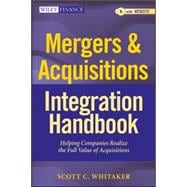
Note: Supplemental materials are not guaranteed with Rental or Used book purchases.
Purchase Benefits
What is included with this book?
SCOTT C. WHITAKER, CMC, is President and CEO of Whitaker & Company, an Atlanta-based consulting and project management firm specializing in helping companies to develop, execute, and implement merger integrations and business strategies designed to achieve growth. Since 2005, Whitaker & Company has been involved in merger integration and strategy and operations projects totaling more than $25 billion for both domestic and international companies.
| Acknowledgments | p. xi |
| Introduction | p. 1 |
| Who Should Use This Book? | p. 1 |
| How This Book Is Set Up | p. 2 |
| Chapter Summaries | p. 2 |
| A Word to the Wise | p. 4 |
| Mergers and Acquisitions 101 and Assessing Integration Complexity and Risk | p. 7 |
| Mergers and Acquisitions 101 | p. 7 |
| Determining Post-Acquisition Integration Scope | p. 8 |
| Assessing Integration Complexity and Risk | p. 11 |
| Summary | p. 18 |
| Making the Business Case for Integration | p. 19 |
| How to Improve Performance | p. 19 |
| The Most Complex Areas | p. 21 |
| Making the Business Case for Integration Support | p. 23 |
| The Challenges of Integration | p. 24 |
| Integration Success Factors | p. 29 |
| Summary | p. 30 |
| An Introduction to Integration Planning | p. 31 |
| Integration Activities | p. 32 |
| Integration Timing | p. 32 |
| Integration and Business Planning | p. 33 |
| Integration Support | p. 35 |
| Summary | p. 37 |
| The Pre-Planning Phase | p. 39 |
| Key Activities | p. 39 |
| Reviewing the Planning Documents | p. 40 |
| Assessing Potential Challenge Areas | p. 42 |
| Summary | p. 45 |
| The Importance of Due Diligence | p. 47 |
| Due Diligence Documents Lists | p. 48 |
| A Few Words about IT Due Diligence | p. 59 |
| Summary | p. 60 |
| Establishing an Integration Management Office | p. 61 |
| Setting Up an IMO | p. 63 |
| Determining Functional Resource Commitments | p. 66 |
| Dedicated versus Matrixed Resources | p. 68 |
| Setting Up an Integration Project Charter | p. 69 |
| Setting Up an Integration Governance Structure | p. 72 |
| Summary | p. 73 |
| Executing Your Integration Plan | p. 75 |
| Functional Work-Plan Elements | p. 76 |
| Integration Work Streams | p. 77 |
| Functional Work-Plan Quality | p. 79 |
| Functions Requiring Extra Attention | p. 82 |
| Summary | p. 85 |
| Planning Your Integration's End State | p. 87 |
| How to Know When an Integration Is Finished | p. 88 |
| The Typical Process: Roles, Responsibilities, Tracking, and Finishing Well | p. 88 |
| Summary | p. 93 |
| Effective Communication Planning | p. 95 |
| Communication Planning Objectives | p. 95 |
| Guiding Principles for an Effective Communication Plan | p. 96 |
| Establishing a Communication Matrix | p. 97 |
| A Proper Communication Process | p. 101 |
| Summary | p. 105 |
| Cultural Integration and Assessment | p. 107 |
| Managing Cultural Integration Activities | p. 107 |
| Culture and Change Management | p. 112 |
| Summary | p. 114 |
| The Talent Assessment Process | p. 115 |
| Talent Assessment Guiding Principles | p. 115 |
| Talent Assessment Objectives | p. 116 |
| Evaluation Tools for Assessing Talent | p. 117 |
| Retention and Separation Guidelines and Policies | p. 118 |
| Dependencies for Talent Assessment and Retention and Separation Activities | p. 123 |
| Things to Avoid | p. 125 |
| Summary | p. 126 |
| Synergy Program Management | p. 127 |
| Effectively Managing Synergies | p. 128 |
| The IMO's Role in Managing a Synergy Program | p. 129 |
| A Typical Synergy Plan | p. 130 |
| Best Practices | p. 137 |
| Summary | p. 138 |
| Information Technology Integration | p. 139 |
| IT's Role within an Integration | p. 140 |
| Day One Planning | p. 144 |
| The Three Risks | p. 146 |
| Summary | p. 147 |
| Integration Feedback: Lessons Learned | p. 149 |
| Goals and Tools of Lessons Learned | p. 149 |
| Getting Feedback and Making Adjustments | p. 150 |
| Collecting Post-Integration Feedback | p. 151 |
| Additional Tips | p. 153 |
| Summary | p. 156 |
| Creating an Integration Playbook | p. 157 |
| Playbook Contents | p. 157 |
| Playbook Elements | p. 159 |
| How the Elements Work Together | p. 161 |
| Applying the Playbook | p. 162 |
| Summary | p. 162 |
| About the Author | p. 163 |
| About the Website | p. 165 |
| Index | p. 167 |
| Table of Contents provided by Ingram. All Rights Reserved. |
The New copy of this book will include any supplemental materials advertised. Please check the title of the book to determine if it should include any access cards, study guides, lab manuals, CDs, etc.
The Used, Rental and eBook copies of this book are not guaranteed to include any supplemental materials. Typically, only the book itself is included. This is true even if the title states it includes any access cards, study guides, lab manuals, CDs, etc.